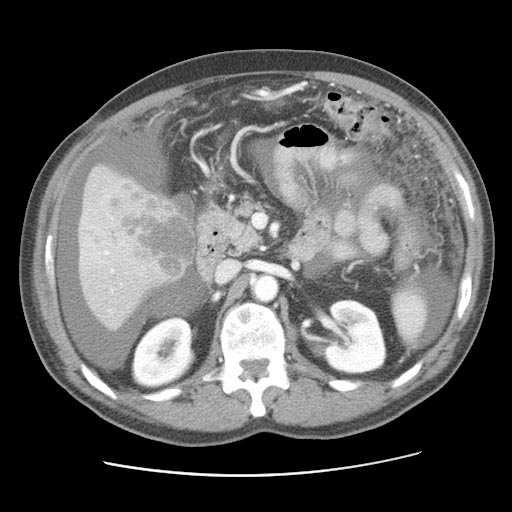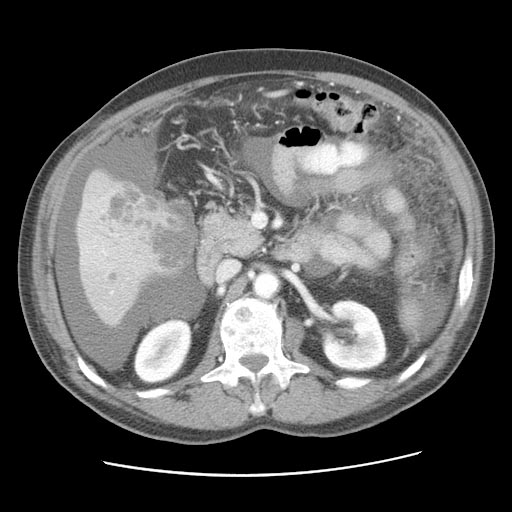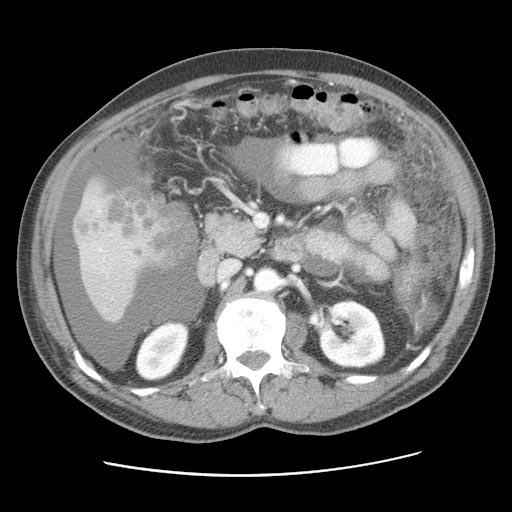Peritoneal carcinomatosis
Editor-In-Chief: C. Michael Gibson, M.S., M.D. [1] Associate Editor(s)-in-Chief: Maria Fernanda Villarreal, M.D. [2]
Synonyms and keywords: Peritoneal metastases
Overview
Peritoneal carcinomatosis (also known as peritoneal metastases) is defined as a malignant tumoral seeding of the peritoneum. Peritoneal carcinomatoses are the most common peritoneal malignancy, these commonly arise from ovarian cancer, colon cancer, gastric cancer, and pancreatic cancer. Calcified peritoneal carcinomatosis may occur in serous ovarian adenocarcinoma, colon cancer, and gastric cancer.
Historical Perspective
- Peritoneal carcinomatosis was first discovered by [scientist name], a [nationality + occupation], in [year] during/following [event].
- In [year], [gene] mutations were first identified in the pathogenesis of peritoneal carcinomatosis.
- In [year], the first [discovery] was developed by [scientist] to treat/diagnose peritoneal carcinomatosis.
Classification
- Peritoneal carcinomatosis may be classified according to [classification method] into [number] subtypes/groups:
- [group1]
- [group2]
- [group3]
- Other variants of peritoneal carcinomatosis include [disease subtype 1], [disease subtype 2], and [disease subtype 3].
Pathophysiology
- The pathogenesis of peritoneal carcinomatosis is characterized by [feature1], [feature2], and [feature3].
- The [gene name] gene/Mutation in [gene name] has been associated with the development of peritoneal carcinomatosis, involving the [molecular pathway] pathway.
- On gross pathology, [feature1], [feature2], and [feature3] are characteristic findings of peritoneal carcinomatosis.
- On microscopic histopathological analysis, [feature1], [feature2], and [feature3] are characteristic findings of peritoneal carcinomatosis.
Causes
- Peritoneal carcinomatosis may be caused by either [cause1], [cause2], or [cause3].
- Peritoneal carcinomatosis is caused by a mutation in the [gene1], [gene2], or [gene3] gene[s].
- There are no established causes for peritoneal carcinomatosis.
Differentiating Peritoneal Carcinomatosis from Other Diseases
- Peritoneal carcinomatosis must be differentiated from other diseases that cause abdominal pain, ascites, and weight loss, such as:
- [Differential dx1]
- [Differential dx2]
- [Differential dx3]
Epidemiology and Demographics
- The prevalence of peritoneal carcinomatosis is approximately [number or range] per 100,000 individuals worldwide.
- In [year], the incidence of peritoneal carcinomatosis was estimated to be [number or range] cases per 100,000 individuals in [location].
Age
- Patients of all age groups may develop peritoneal carcinomatosis.
- Peritoneal carcinomatosis is more commonly observed among patients aged [age range] years old.
- Peritoneal carcinomatosis is more commonly observed among [elderly patients/young patients/children].
Gender
- Peritoneal carcinomatosis affects men and women equally.
- [Gender 1] are more commonly affected with peritoneal carcinomatosis than [gender 2].
- The [gender 1] to [Gender 2] ratio is approximately [number > 1] to 1.
Race
- There is no racial predilection for peritoneal carcinomatosis.
- Peritoneal carcinomatosis usually affects individuals of the [race 1] race.
- [Race 2] individuals are less likely to develop peritoneal carcinomatosis.
Risk Factors
- Common risk factors in the development of peritoneal carcinomatosis are [risk factor 1], [risk factor 2], [risk factor 3], and [risk factor 4].
Natural History, Complications and Prognosis
- The majority of patients with peritoneal carcinomatosis remain asymptomatic for [duration/years].
- Early clinical features include [manifestation 1], [manifestation 2], and [manifestation 3].
- If left untreated, [#%] of patients with peritoneal carcinomatosis may progress to develop [manifestation 1], [manifestation 2], and [manifestation 3].
- Common complications of peritoneal carcinomatosis include [complication 1], [complication 2], and [complication 3].
- Prognosis is generally [excellent/good/poor], and the [1/5/10year mortality/survival rate] of patients with peritoneal carcinomatosis is approximately [#%].
Diagnosis
Diagnostic Criteria
- The diagnosis of peritoneal carcinomatosis is made when at least [number] of the following [number] diagnostic criteria are met:
- [criterion 1]
- [criterion 2]
- [criterion 3]
- [criterion 4]
Symptoms
- Peritoneal carcinomatosis is usually asymptomatic.
- Symptoms of peritoneal carcinomatosis may include the following:
- Abdominal distention
- Nausea
- Bloating
- Intermittent abdominal pain
- Vomiting
- Alternating diarrhea and constipation
Physical Examination
- Patients with peritoneal carcinomatosis usually appear pale and lethargic.
- Physical examination may be remarkable for:
Inspection
- Enlarged abdomen
- Abdominal distention
Palpation
- Bulging of the flanks or shifting dullness
- Fluid thrill or fluid wave
- Other physical examination findings may include:
- Leg swelling
- Bruising
- Gynecomastia
Laboratory Findings
- There are no specific laboratory findings associated with peritoneal carcinomatosis.
- A [positive/negative] [test name] is diagnostic of peritoneal carcinomatosis.
- An [elevated/reduced] concentration of [serum/blood/urinary/CSF/other] [lab test] is diagnostic of peritoneal carcinomatosis.
- Other laboratory findings consistent with the diagnosis of peritoneal carcinomatosis include [abnormal test 1], [abnormal test 2], and [abnormal test 3].
Imaging Findings
- Enhanced CT scan is the imaging modality of choice for peritoneal carcinomatosis.
- On CT, peritoneal carcinomatosis is characterized by the following findings:
- Smooth or nodular peritoneal thickening and enhancement.
- Implants on the liver and the splenic surfaces are frequently seen and result in scalloping of the surface by the masses.
- Sites of tumor implantation are the intersegmental fissure, superior recess of the lesser sac, subphrenic space, and Morison pouch.
- Usually there is large ascites, which is often loculated.
- The images below demonstrate a case of peritoneal carcinomatosis.
Other Diagnostic Studies
- Peritoneal carcinomatosis may also be diagnosed using abdominal paracentesis.
- Findings on paracentesis may include:
- Opalescent appearance
- Elevated protein concentration (more than 4.0 g/dL)
- Abnormal serum-ascites albumin gradient ( less than 1.1 g/dL )
Treatment
Medical Therapy
- There is no treatment for peritoneal carcinomatosis; the mainstay of therapy is supportive care.
- The mainstay of therapy for peritoneal carcinomatosis is [medical therapy 1] and [medical therapy 2].
- [Medical therapy 1] acts by [mechanism of action1].
- Response to [medical therapy 1] can be monitored with [test/physical finding/imaging] every [frequency/duration].
Surgery
- Surgery is the mainstay of therapy for peritoneal carcinomatosis.
- [Surgical procedure] in conjunction with [chemotherapy/radiation] is the most common approach to the treatment of peritoneal carcinomatosis.
- [Surgical procedure] can only be performed for patients with [disease stage] peritoneal carcinomatosis.
Prevention
- There are no primary preventive measures available for peritoneal carcinomatosis.
- Once diagnosed and successfully treated, patients with peritoneal carcinomatosis are followed-up every [duration]. Follow-up testing includes [test 1], [test 2], and [test 3].


